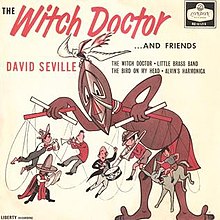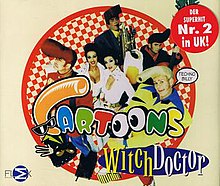
Liberty Records was a record label founded in the United States by chairman Simon Waronker in 1955 with Alvin Bennett as president and Theodore Keep as chief engineer. It was reactivated in 2001 in the United Kingdom and had two previous revivals.
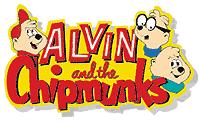
Alvin and the Chipmunks, originally David Seville and the Chipmunks and billed for their first two decades as the Chipmunks, are an American animated virtual band and media franchise first created by Ross Bagdasarian for novelty records in 1958. The group consists of three singing animated anthropomorphic chipmunks named Alvin, Simon, and Theodore.
David "Dave" Seville is a fictional character, the adoptive father and producer and manager of the fictional singing group Alvin and the Chipmunks. The character was created by Ross Bagdasarian Sr., who had used the name "David Seville" as his stage name prior to the creation of the Chipmunks, while writing and recording novelty records in the 1950s. One of the records, recorded in 1958 under the David Seville stage name, was "Witch Doctor", featuring a sped-up high-pitched vocal technique. Bagdasarian would later use that technique in "The Chipmunk Song ", which would introduce both Alvin and the Chipmunks as a singing group and Bagdasarian's music producer "Dave". Bagdasarian would go on to create The Alvin Show, based on the Alvin and the Chipmunks group, where he voiced the semi-fictional character David Seville, based largely on himself, with Alvin based on Ross's sometimes rebellious son Adam.

Ross S. Bagdasarian Sr., known professionally by his stage name David Seville, was an Armenian-American singer, songwriter, record producer, and actor, best known for creating the cartoon band Alvin and the Chipmunks. Initially a stage and film actor, he rose to prominence in 1958 with the songs "Witch Doctor" and "The Chipmunk Song ", which both became Billboard number-one singles. He produced and directed The Alvin Show, which aired on CBS in 1961–1962.

The Chipmunk Adventure is a 1987 American animated musical-adventure comedy film based on the Saturday-morning cartoon series Alvin and the Chipmunks and the Alvin and the Chipmunks virtual brand and media franchise created by Ross Bagdasarian Sr.. Directed by Janice Karman and written by Karman and Ross Bagdasarian Jr., it follows the Chipmunks and the Chipettes as they go on a hot air balloon race around the world that is the cover for a diamond smuggling ring while their owner David is out on a trip and being hunted down by Claudia and Klaus Furschtein.

"Chantilly Lace" is a 1958 rock and roll song by The Big Bopper. It was produced by Jerry Kennedy, and reached No. 6 on the US Billboard Hot 100. Bruce Channel covered the song on his 1962 album, Hey! Baby. The song was also covered by Jerry Lee Lewis in 1972.
"Come On-a My House" is a song performed by Rosemary Clooney and originally released in 1951. It was written by Ross Bagdasarian and his cousin, Armenian-American Pulitzer Prize-winning author William Saroyan, while driving across New Mexico in the summer of 1939. The melody is based on an Armenian folk song. The lyrics reference traditional Armenian customs of inviting over relatives and friends and providing them with a generously overflowing table of fruits, nuts, seeds, and other foods.

Chipmunk Punk is an album by the Chipmunks, as well as being the first album released by Ross Bagdasarian Jr., after he took over the voices of the Chipmunks after the death of his father in 1972. Despite the title of the album, none of the songs listed are considered to be in the style of real punk rock music. It was released in June 1980. The album peaked at No. 34 on the Billboard 200. It was certified gold by the RIAA on October 14, 1980, becoming the Chipmunks' first gold record. In 2005, it was re-released on CD, although the CD was only available through the official Chipmunks website. In Canada, the album reached No. 59.

"Sidewalk Talk" is a song by American record producer John "Jellybean" Benitez from his first extended play, Wotupski!?! (1984). It was released on October 21, 1984, by EMI Records as the first single from the EP. The song was written by Madonna and produced by Benitez. They had initially met in 1983 and Benitez worked as a producer on Madonna's self-titled debut album. When he started work on his debut EP, Wotupski!?!, Madonna wrote "Sidewalk Talk" for him. The song features bass and electric guitars, synthesizers, piano, and drums. Lead vocals are by Catherine Buchanan with additional chorus vocals by Madonna.

"The Chipmunk Song (Christmas Don't Be Late)" is a novelty Christmas song written by Ross Bagdasarian (under the stage name of David Seville) in 1958. Bagdasarian sang and recorded the song, varying the tape speeds to produce high-pitched "chipmunk" voices, with the vocals credited to Alvin and the Chipmunks, Seville's cartoon virtual band. The song won three Grammy Awards in 1958, for Best Comedy Performance, Best Children's Recording, and Best Engineered Record (non-classical); it was also nominated for Record of the Year.

Sing Again with The Chipmunks is Alvin and the Chipmunks' second album, released by Liberty Records in January 1960. The album follows the same format as their first album, and contains the group's fifth and sixth singles—"Alvin's Orchestra" and "Comin' 'Round the Mountain". Since its initial release, Sing Again with The Chipmunks has appeared twice on CD; both releases utilized the revised 1961 cover artwork, minus the song lyrics printed on the original back cover.

The Alvin Show is a music album by Alvin and the Chipmunks. It is the soundtrack album to the Chipmunks' first animated television series The Alvin Show. Upon the release of the album, the Chipmunks' first three albums were reissued with revised album cover art that utilized the cartoon redesigns of the characters.
Cartoons, also known as Cartoons DK, are a Eurodance band from Denmark, best known for their song "DooDah!" and their cover of the 1958 novelty song "Witch Doctor", both hits released in 1998.
"I'm Sorry" is a 1960 hit song by 15-year-old American singer Brenda Lee. The song was written by Dub Allbritten and Ronnie Self. It peaked at No. 1 on the Billboard Hot 100 singles chart in July 1960. On the UK Singles Chart, the song peaked at No.12. AllMusic guide wrote that it is the pop star's "definitive song", and one of the "finest teen pop songs of its era". In 1999, the 1960 recording by Lee on Decca Records was inducted into the Grammy Hall of Fame.

"Alvin's Harmonica" is a song from the fictional musical group, Alvin and the Chipmunks, which also features additional vocals by Ross Bagdasarian, Sr. who plays David Seville in the song. The song was released as the second single from the group's debut album, Let's All Sing with the Chipmunks in 1958. Like "Witch Doctor" and "The Chipmunk Song", it was adapted as one of the musical segments featured in The Alvin Show.
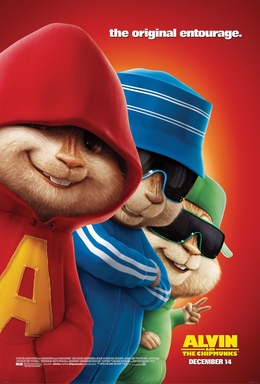
Alvin and the Chipmunks is a 2007 American jukebox musical comedy film directed by Tim Hill from a screenplay by Jon Vitti and the writing team of Will McRobb and Chris Viscardi, based on the characters of the same name created by Ross Bagdasarian Sr.. The film stars Jason Lee, David Cross and Cameron Richardson, while Justin Long, Matthew Gray Gubler and Jesse McCartney voice the titular Chipmunks. The film follows the Chipmunks, who move in with struggling songwriter Dave Seville after they lose their home. When Dave discovers they have rare singing talent, he has them perform in front of JETT Records executive Ian Hawke, who then plans to trick them into living with him to profit off their success with a world tour.

The Chipmunks Go to the Movies is a 1969 music album by David Seville and Alvin and the Chipmunks, released by Sunset Records, the budget-line subsidiary of Liberty Records.
This is the complete discography of the fictional music group Alvin and the Chipmunks.
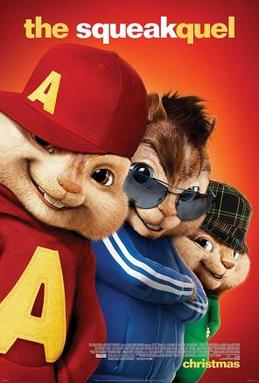
Alvin and the Chipmunks: The Squeakquel is a 2009 American live-action/animated jukebox musical comedy film directed by Betty Thomas and written by Jon Vitti and the writing team of Jonathan Aibel and Glenn Berger, based on the characters Alvin and the Chipmunks created by Ross Bagdasarian Sr. and the Chipettes created by Janice Karman. It is the second installment in the live-action Alvin and the Chipmunks film series and the sequel to Alvin and the Chipmunks (2007). The film stars Zachary Levi, David Cross and Jason Lee. Justin Long, Matthew Gray Gubler and Jesse McCartney return to voice the Chipmunks from the previous film. Christina Applegate, Anna Faris and Amy Poehler voice the new characters, the Chipettes. The film sees the Chipmunks entering high school and being under the care of Dave Seville's cousin, Toby, while Ian Hawke recruits the Chipettes to restore his career.
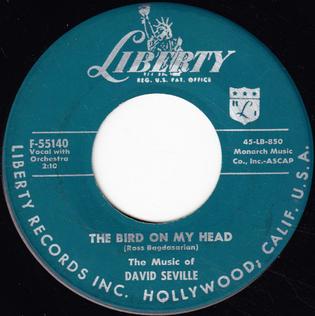
"The Bird on My Head" is a 1958 novelty song by Ross Bagdasarian.
